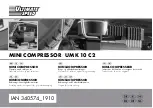
SN55, SN55S, SN55V, SN75, SN75S, SN75V User Manual
6: Maintenance
02250247-571 R04
Subject to EAR, ECCN EAR99 and related export control restrictions.
74
6.10 Water condensate drain
maintenance
If your compressor is fitted with the standard solenoid
condensate drain valve, it is necessary to periodically
clean the strainer. Remove the hex cap from the strainer
and remove the strainer screen. Clean the screen and
reinstall. If the screen is damaged, the strainer assembly
must be replaced (P/N 241772).
6.11 Control line strainer
The regulator and solenoid valve(s), which control the
compressor, are protected by a strainer. Every 12 months
it is necessary to clean the strainer. Remove the hex cap
from the strainer and remove the strainer screen. Clean
the screen and reinstall. If the screen is damaged, the
strainer assembly must be replaced (P/N 241772).
6.12 Shaft coupling maintenance
The compressor unit and motor are rigidly connected via
a mounting adapter housing. This arrangement makes
coupling alignment unnecessary. The coupling is a jaw
type in shear. If the elastomeric element requires
replacement due to wear or breakage, order replacement
element no. 02250152-670, and follow the following
steps.
1. Remove the protective grill from the adapter
housing.
2. Loosen the retaining screw located on the outer
sleeve. Slide the sleeve to one side, exposing
the coupling element.
3. Unwrap the coupling element from the coupling
jaws.
4. Install the new element by wrapping it around the
jaws, engaging the cogs on the element into the
jaws.
5. Reinstall the outer sleeve and the protective grill.
Secure the outer sleeve by tightening the two
screws to 45 in·lbs (5 N·m).
6.13 Troubleshooting
6.13.1 Introduction
The information contained in the Troubleshooting Guide
has been compiled from field report data and factory
experience. It contains symptoms and usual causes for
the described problems. However, DO NOT assume that
these are the only problems that may occur. All available
data concerning a problem should be systematically ana-
lyzed before undertaking any repairs or component
replacement procedures.
A detailed visual inspection is worth performing for
almost all problems and may avoid unnecessary addi-
tional damage to the compressor. Always remember to:
• Check for loose wiring.
• Check for damaged piping.
• Check for parts damaged by heat or an electrical
short circuit, usually apparent by discoloration or a
burnt odor.
Should your problem persist after making the recom-
mended check, consult your nearest Sullair representa-
tive.
6.13.2 Troubleshooting guide
Symptom
Probable cause
Remedy
Compressor will not
start
Main disconnect switch open
Close switch.
Line fuse blown
Replace fuse.
Motor starter overload tripped
Reset. Should trouble persist, check whether
motor starter contacts are functioning properly.
Low incoming line voltage
Check voltage. Should voltage check low, con-
sult power company.






































